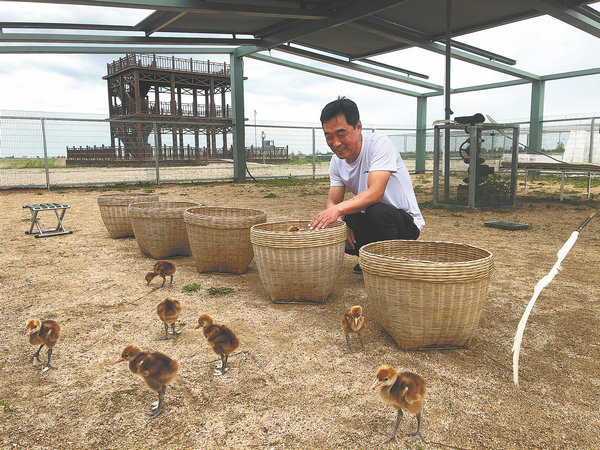

Zhao Shiwei and his team have bred and rescued more than 200 red-crowned cranes and released them into the wild after ensuring they will be able to survive in the wild. Despite doing this for 30 years and loving every moment of it, Zhao's greatest wish is to see his enclosure in Panjin city, Liaoning province, free of cranes.
The red-crowned crane is a national first-class protected wildlife, with the coastal wetlands of Panjin city being one of its important resting, wintering, and breeding grounds in the East Asia-Australasia Flyway for birds.
But due to environmental and ecological damage, the number of red-crowned cranes migrating to the Liaohe River estuary had been continuously declining when Zhao joined work at the Zhaoquan River Management Station, which is part of the Liaohe River Estuary National Nature Reserve in Panjin, in 1992.
Artificial breeding of red-crowned cranes became an important part of Zhao's work. Three red-crowned crane chicks hatched at the station through artificial insemination in 1996. The sight of red-crowned crane chicks emerging from the eggs was extremely exciting for Zhao. "At that moment … I felt that I had found something very meaningful in life," Zhao said.
But despite tasting success in 1996 and receiving encouragement from senior officials, Zhao and his team encountered setbacks the following year. In 1997, not a single red-crowned crane chick hatched. And in 1998, only one red-crowned crane chick hatched through artificial insemination, but it died soon after."Was I suited for this work? At that time, I had many confusing thoughts," Zhao said.
The station director at the time noticed his emotional state and told him that artificial breeding of red-crowned cranes at the station was pioneering work that required continuous exploration, and asked him,"How could we give up in the face of difficulties?"
In 1999, the station rescued several injured red-crowned cranes from the wild.
That prompted Zhao and his colleagues to check the incubator, brooder, temperature control devices and voltage, go through a huge amount of data, seek advice from experts in Shenyang, the provincial capital, and improve the incubator, hoping to achieve a breakthrough in artificial breeding.
"We tried every possible method, even consulting technicians from nearby chicken farms," Zhao said. Thanks to such efforts over the years, the artificial breeding program has continued to improve.
Last year, a record 85 red-crowned crane chicks hatched at the station through a combination of artificial insemination and natural breeding methods. Over the past 30 years, Zhao has trained many apprentices, but he has always been personally involved in the hatching process. "This part is the most crucial; there cannot be the slightest mistake," he said.
Zhao has set 12 alarms, one for every two hours, on his phone, because during the incubation period, the eggs have to be turned, and ventilation and temperature checked every two hours, whether it's day or night.
Zhao has extensive experience in feeding red-crowned crane chicks, too. "For chicks aged 1 to 20 days, they are fed five times a day; for those between 21 and 30 days old, they are fed four times a day; and for those more than 30 days old, they are fed three times a day," he said.
In 2005, Zhao realized that with the number of artificially bred red-crowned cranes increasing, the bond between the cranes and humans was growing stronger. But "they are the spirits of nature and hence should return to nature",Zhao said.
Hence, Zhao applied to the higher authorities to provide outdoor "training" to artificially bred red-crowned cranes in the reserve in order to increase the number of wild red-crowned cranes. "After feeding all the red-crowned cranes every morning, I take the young 'trained' ones 'out for a walk' when they can forage and practice flying, and bring them back to the enclosure in the evening," Zhao said.
Once, due to an emergency rescue of other birds, two cranes "undergoing training" did not return to the enclosure on time. In the evening, Zhao searched for them in the reed marshes for seven hours, and finally found the two lost chicks. And only then he realized that the soles of his shoes had come off during the search.
Starting in 2010, during the bird migration season, stray cranes have been flying into the reserve and staying for a long time. That prompted Zhao to release several artificially bred adult male red-crowned cranes into the wild every year so they could form families with their wild partners and increase the wild crane population in Panjin.
"The method has proved quite effective. We often see two pairs of cranes leisurely foraging by the roadside or riverbank, and they are not as afraid of people as a totally wild pair or flock would be. Sometimes, they even fly with their chicks to visit the station," Zhao said, calling himself not only a trainer of red-crowned cranes but also a matchmaker.
yandongjie@chinadaily.com.cn